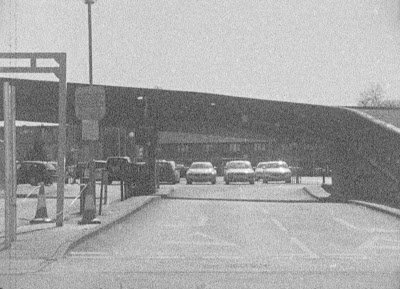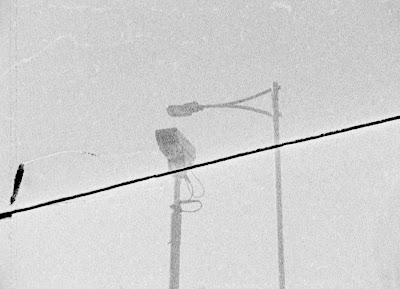Two years ago, I made a very short film called 'Workers Not Leaving the Factory'. The rationale for this was to record moving images onto Ilford film of the sites of the Ilford’s Britannia Works factory in the town of the same name, identifying two locations that would have been exits from the site at the time that the Lumière brothers filmed La Sortie de l'Usine Lumière à Lyon, its title variously translated into English as Workers Leaving The Lumière Factory in Lyon, Employees Leaving the Lumière Factory, or Exiting the Factory, the first film to be projected in front of an audience, at the Société d'Encouragement de l'Industrie Nationale, on 22nd March 1895. Last year I had the desire to revisit this, 125 years to the day on which the Lumières’ films were first shown to a paying audience in London, but did not do so due to the pandemic restrictions in force on that date. Instead, I made a rather imperfect contact print of the first film to project it at home, alongside a digital projection from a webcam that provided the nearest possible view to those which I had filmed, a visual representation of how the moving image and its dissemination has fundamentally changed the experience of time and space, echoing Patrick Keiller’s desire to make a film of “distant landscapes […] without leaving home.” This was 'ADDITIONAL POURTRAYALS [sic]', the name derived from a phrase in the original programme for the Lumières’ first exhibition of the cinématographe in England, in which I speculated, that, although La Sortie de l'Usine Lumière à Lyon was not named as one of the films shown, it could have appeared as one of these ‘ADDITIONAL POURTRAYALS’.
 |
| ADDITIONAL POURTRAYALS [sic] |
 |
| Ilford Fast Pan 16mm Film |
 |
| Roden Street, Ilford |
The Ciné-Kodak BB Junior takes 50ft daylight loading spools, which equates to around 2 minutes at the camera’s frame rate of 16 frames a second. When I filmed 'Workers Not Leaving the Factory', as the 2x8mm format requires the film to be passed through the camera twice, there was a logic to shooting two separate scenes, between which the film needed to be unloaded from the camera, the spools flipped over and then reloaded to shoot the second side of the film. In doing this, I chose the locations where two entrances to the Britannia Works site had been, having researched the site history in some detail in 2013. The first location was the entrance to Sainsbury's car park on Roden Street, the other a section of brick wall on Riverdene Road, which appears to align with what was once the entrance to an alley that led into Britannia Works. The Ciné-Kodak BB Junior runs for just over 30 seconds with its clockwork motor fully wound, this would determine the duration of each scene: I assumed that I would then get four different shots on the 50ft spool; in the event, there was enough film for five scenes, partly due to unloading the camera after shooting in the dark (the footage indicator on the camera suggests that there’s about five feet of film after the zero mark which would usually be exposed when removing the film from the camera).
 |
| Riverdene Road, Ilford |
I filmed the same two locations as in 'Workers Not Leaving the Factory' for the first two shots. The next two sites where those related to 'ADDITIONAL POURTRAYALS [sic]': the CCTV camera which records the scene that I had projected digitally, and then I pointed the BB Junior in the same direction as this CCTV camera, but from the ground level of course. This viewpoint was as close as I could get to the scene of the Britannia Works site remotely: at some point in the evolution of Ilford’s sprawling site, it might have been possible to see part of it from here, namely the skating rink which Ilford rented in the 1930s. Reading accounts of the history of early film in Britain in In the Kingdom of Shadows recently, I couldn't help noticing that the cinema was linked to skating in a couple of accounts, usually in the nature of popular fads or crazes:
“SEVERAL EXPLANATIONS have been given of the bad theatrical business in the provinces, reports of which daily reach the managers most concerned in sending out companies. […] Mr. George Dance, who has as much experience of the business side of the theatre as anyone in England, is inclined to think that the comparative effect of cinematograph shows and skating rinks has been exaggerated.”The World’s Fair, 30 October 1909“AT THE PRESENT MOMENT the popularity of picture palaces and the reason for it are directing a good deal of attention to the public mind. But these sudden crazes are not new: 30 years ago it was croquet, 15 years ago it [was] cycling, ten years ago it was roller skating…”
The Times, 9th April 1913
 |
| Site of Alfred Harman's house, Cranbrook Road |
With the nominally-50ft roll not entirely used up, I went to the site of Alfred Harman’s house on Cranbrook Road, where Harman first coated glass plates in the basement, the very beginnings of what would become Ilford, Limited. When I developed the film, I used the developing times for Ilford FP4 Plus with Adox Adonal, an iteration of Rodinal. The developing tank I have been using for 16mm is really designed for 2x8mm: a normal 2x8mm camera roll is 25ft, but, with enough film for a leader and trailer, usually removed after processing, the actual length is closer to 33ft; this does still mean that a 50ft daylight spool has to be developed in two parts, if not strictly halves. The cut appears part way through the third scene shot, spliced together again after developing.
 |
| Cut between two lengths of the film developed separately |
The direction of the film through the camera means that the second half of the film was first to be developed first, for which I used a dilution of 1+50 for 15 minutes; the negative looked dense, so I reduced the time for the second half of the film to 12 minutes, which possibly could have been cut further (subsequently using the Ilford Fast Pan film, I’ve rated it at 40 or 50 rather than 25; in the image above it's just possible to discern that the image is brighter, thus the negative is denser, below the cut.). The nature of the film's age and overexposure and/or overdevelopment is that the images have quite pronounced grain as a result. Having developed the film by hand, the cleanness of the process itself could clearly be improved. In addition, by letting the camera’s motor run down entirely while exposing the film is that the frame rate slows close to the end, before the motor stops, with the result that the exposure time increases, the image getting brighter at the end of each scene. With the methodology determining the location and duration of each shot, anything happening in front of the camera was at the mercy of what Siegfried Kracauer would describe as ‘the contingency of the street’: the entrance to the supermarket car park and the road underneath the A406 flyover inevitably provided movement; the CCTV camera was shot hand-held, and a bird can be discerned flying through the shot at one point; the brick wall on Riverdene Road is only animated by subtle signs of the wind in the netting on the scaffolding which appears in the corner of the frame and the shadows from a tree on the right. Movement is also provided by the lack of stability of the frames and the vibrations the camera itself is subject to as the motor unwinds, rotating the shutter, pulling the film from supply to take up spool inside the camera, the intermittent motion briefly pausing its travel at the film gate for sixteen exposures every second.
'With Workers Not Leaving The Factory', showing the two individual frames next to each other had a logic thanks to the nature of the 2x8mm film format. In 16mm, there was a coherence to keeping the revisited scenes in juxtaposition; with the following shots as an angle-reverse angle pair, this had also had a reason to be placed together after the first two. The fifth shot I discarded.
Sources/Further reading:
Colin Harding and Simon Popple, In the Kingdom of Shadows, Cygnus Arts, London 1996
Patrick Keiller, 'The Robinson Institute', The View From the Train, Verso 2013
Siegfried Kracauer, Nature of Film: The Redemption of Physical Reality, Dobson Books, 1970
No comments:
Post a Comment